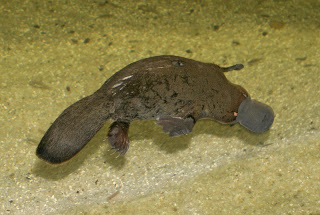Snakes and spiders are obvious examples of animals that are capable of producing venom, which they employ to capture prey and/or defend against predators. However, one does not generally associate mammals with being venomous (unless of course, one is a mammalogist or is exceptionally good with trivia). Truly I say to you, several mammals are indeed venomous, possessing the biochemical means to produce toxins solely for the purpose of using them against other animals. They include the platypus, solenodons, the slow loris, and several species of shrew. Here's the breakdown:
Blarina toxin
 The venomous saliva of northern short-tailed shrew (Blarina brevicauda), which is native to North America and is roughly the size of a house mouse, is known to contain at least one toxic compound, blarina toxin (BLTX). This shrew is an insatiable little bugger, eating almost constantly due to its incredibly high metabolic rate. It is thought that it uses its venomous saliva to paralyze and catch prey larger than itself, such as rodents and frogs, in order to satisfy its extreme hunger. The shrew produces BLTX in its salivary glands, such that it is secreted along with, and so present in, its saliva.
The venomous saliva of northern short-tailed shrew (Blarina brevicauda), which is native to North America and is roughly the size of a house mouse, is known to contain at least one toxic compound, blarina toxin (BLTX). This shrew is an insatiable little bugger, eating almost constantly due to its incredibly high metabolic rate. It is thought that it uses its venomous saliva to paralyze and catch prey larger than itself, such as rodents and frogs, in order to satisfy its extreme hunger. The shrew produces BLTX in its salivary glands, such that it is secreted along with, and so present in, its saliva.
BLTX is a tissue kallikrein-like protease, an enzyme capable of cleaving kinins, such as bradykinin, from precursor proteins known as kininogens. Bradykinin produces vasodilatation (widening of the blood vessels), contraction of smooth muscle, increased vascular permeability, and pain. In mice, BLTX causes rapid and irregular respiration, hypotension (decreased blood pressure), hind limb paralysis, and convulsions, with death generally occurring 3-5 hr after exposure. I'm guessing that the respiratory difficulties and hypotension are at least partly the result of systemic vasodilatation and bronchial constriction mediated by the bradykinin that is released by the toxin. The actual mechanism by which the venom causes death is still unknown. Since humans are much larger than rodents and frogs, if we are bitten by B. brevicauda the quantity of venom is presumably insufficient to produce a systemic reaction, such that only a local inflammation (burning sensation, redness, swelling), likely due to BLTX-mediated bradykinin release, is typically observed at the site of the bite.
Platypus venom

Not only is the Australian duck-bill platypus (Ornithorhynchus anatinus) one of only five species of mammals that lay eggs, it is also one of the few mammals that produce venom. Male platypuses possess spurs on their hind limbs which they use to deliver a venom produced in pelvic venom glands as an offensive and defensive weapon. Envenomation (getting the venom injected into you) causes a severe localized response featuring intense pain, hyperalgesia (increased sensitivity to pain), and plasma extravasation (swelling due to fluid entering the tissue from blood vessels). When administered systemically to lab animals, the venom causes hypotension and peripheral vasodilatation (increased blood flow to the skin and other body surfaces). The mechanisms by which these effects are produced is unknown.
What is known is that platypus venom contains at least 19 different peptide/protein components, including two C-type natriuretic peptides (OvCNPa and OvCNPb) and four defensin-like peptides (DLPs). C-type natriuretic peptides are naturally produced by endothelial cells (form the innermost layer of blood vessels) in mammals and have been found in brain, intestine, and kidney. Their primary function is thought to be to regulate blood flow by causing vasodilatation. These peptides have been found in the venom of the South American pit viper (Bothrops neuwiedi), suggesting that they are capable of producing toxic effects as well. Defensins are small peptides found in a wide variety of invertebrates and vertebrates that are capable of killing bacteria, fungi, and viruses. Interestingly, the DLPs in platypus venom have not been shown to possess antimicrobial activity, suggesting they may have a role in mediating the toxic effects of the venom instead.
OvCNPa and OvCNPb have been shown to cause the release of histamine from mast cells, an important process in the development of inflammation. This would explain the swelling and increased sensitivity to pain. Additionally, platypus venom is capable of causing the formation of voltage-dependent ion channels in artificial cell membranes, with OvCNPa and OvCNPb having been shown to have a role in this phenomenon. It has been suggested that these channels, by altering membrane potentials and/or the movement of calcium ion across cell membranes, can modulate signal transduction pathways in cells so as to adversely affect cellular functions.
Kita M, Nakamura Y, Okumura Y, Ohdachi SD, Oba Y, Yoshikuni M, Kido H, Uemura D. Blarina toxin, a mammalian lethal venom from the short-tailed shrew Blarina brevicauda: Isolation and characterization. Proc Natl Acad Sci USA. 2004 May 18;101(20):7542-7.
Kourie JI. Characterization of a C-type natriuretic peptide (CNP-39)-formed cation-selective channel from platypus (Ornithorhynchus anatinus) venom. J Physiol. 1999 Jul 15;518 (Pt 2):359-69.
Torres AM et al. Mammalian l-to-d-amino-acid-residue isomerase from platypus venom. FEBS Lett. 2006 Mar 6;580(6):1587-91.
http://en.wikipedia.org/wiki/Northern_Short-tailed_Shrew




